Modelling the Effect of Keyline Practice on Soil Erosion Control
Abstract
:1. Introduction
2. Materials and Methods
- Surface water regulation: creation of temporary ditches every 25 m along keylines with a depth of 20 cm;
- Tillage: subsoiling at a depth of 30 cm parallel to the keylines.
3. Results
4. Discussion
5. Conclusions
Author Contributions
Funding
Informed Consent Statement
Data Availability Statement
Acknowledgments
Conflicts of Interest
References
- Van der Knijff, J.M.F.; Jones, R.J.A.; Montanarella, L. Soil Erosion Risk Assessment in Italy; EUR 19022; European Soil Bureau, European Commission: Brussels, Belgium, 1999; 32p. [Google Scholar]
- Bathurst, J.C. Decision support system for desertification mitigation in the Agri basin, southern Italy. Phys. Chem. Earth 2003, 28, 579–587. [Google Scholar] [CrossRef]
- Egidi, G.; Cividino, S.; Paris, E.; Palma, A.; Salvati, L.; Cudlin, P. Assessing the impact of multiple drivers of land sensitivity to desertification in a Mediterranean country. Environ. Impact Assess. Rev. 2021, 89, 106594. [Google Scholar] [CrossRef]
- Nickayin, S.S.; Coluzzi, R.; Marucci, A.; Bianchini, L. Desertification risk fuels spatial polarization in ‘affected’ and ‘unaffected’ landscapes in Italy. Sci. Rep. 2022, 12, 747. [Google Scholar] [CrossRef] [PubMed]
- Imbrenda, V.; Coluzzi, R.; Di Stefano, V.; Egidi, G.; Salvati, L.; Samela, C.; Simoniello, T.; Lanfredi, M. Modeling Spatio-Temporal Divergence in Land Vulnerability to Desertification with Local Regressions. Sustainability 2022, 14, 10906. [Google Scholar] [CrossRef]
- Salvati, L.; Bajocco, S. Land sensitivity to deserti fi cation across Italy: Past, present, and future. Appl. Geogr. 2011, 31, 223–231. [Google Scholar] [CrossRef]
- Pagliai, M. Conoscenza, conservazione e uso sostenibile del suolo: Aspetti fisici e morfologici. Ital. J. Agron. 2009, 4, 151–160. [Google Scholar] [CrossRef]
- Palese, A.M.; Vignozzi, N.; Celano, G.; Agnelli, A.E.; Pagliai, M.; Xiloyannis, C. Influence of soil management on soil physical characteristics and water storage in a mature rainfed olive orchard. Soil Tillage Res. 2014, 144, 96–109. [Google Scholar] [CrossRef]
- Shukla, P.R.; Skeg, J.; Calvo Buendia, E.; Masson-Delmotte, V.; Pörtner, H.-O.; Roberts, D.C.; Zhai, P.; Slade, R.; Connors, S.; van Diemen, S.; et al. Climate Change and Land: An IPCC Special Report on Climate Change, Desertification, Land Degradation, Sustainable Land Management, Food Security, and Greenhouse Gas Fluxes in Terrestrial Ecosystems; IPCC Press Office: Geneva, Switzerland, 2019; pp. 35–74. [Google Scholar]
- Yeomans, P.A. The Challenge of Landscape: The Development and Practice of Keyline. Geogr. Rev. 1958, 50, 463. [Google Scholar] [CrossRef]
- Yeomans, P.A. The Keyline plan. Creat. Indep. Publ. Platf. 1954, 22, 120pp. [Google Scholar] [CrossRef]
- Duncan, T. Case Study: Taranaki Farm Regenerative Agriculture. Pathways to Integrated Ecological Farming; Elsevier Inc.: Amsterdam, The Netherlands, 2016; ISBN 9780128013533. [Google Scholar]
- Gras, E. Cosecha de agua y tierra Diseño con permacultura; Ediciones COAS: Navarra, Spain, 2009. [Google Scholar]
- Pavlov, G. Uderstanding the Application of Keyline Geometry; HUMA: Samuel, Bulgaria, 2015. [Google Scholar]
- Mancini, M. Agricoltura Organica e Rigenerativa Oltre il Biologico: Le Idee, gli Strumenti e le Pratiche per Un’agricoltura di Qualità; Terra Nuova Ed.: Firenze, Italy, 2019. [Google Scholar]
- Ponce-Rodríguez, M.D.C.; Carrete-Carreón, F.O.; Núñez-Fernández, G.A.; Muñoz-Ramos, J.d.J.; Pérez-López, M.E. Keyline in bean crop (Phaseolus vulgaris l.) for soil and water conservation. Sustainability 2021, 13, 9982. [Google Scholar] [CrossRef]
- Duncan, S.; Krawczyk, T. Keyline Water Management: Field Research & Education in the Capital Region Soil Indicators Monitoring Program. 2018. Available online: http://crkeyline.ca (accessed on 9 December 2022).
- Al-Siaede, R. Using Landscape analysis techniques to prevent silt accumulation in the reservoir of the Dwerige weir project and developing River basin, Missan, South Eastern IRAQ. Iraqi J. Sci. 2022, 63, 3031–3039. [Google Scholar] [CrossRef]
- Wang, D.; Yuan, Z.; Cai, Y.; Jing, D.; Liu, F.; Tang, Y.; Song, N.; Li, Y.; Zhao, C.; Fu, X. Characterisation of soil erosion and overland flow on vegetation-growing slopes in fragile ecological regions: A review. J. Environ. Manag. 2021, 285, 112165. [Google Scholar] [CrossRef] [PubMed]
- Rutebuka, J.; Munyeshuli Uwimanzi, A.; Nkundwakazi, O.; Mbarushimana Kagabo, D.; Mbonigaba, J.J.M.; Vermeir, P.; Verdoodt, A. Effectiveness of terracing techniques for controlling soil erosion by water in Rwanda. J. Environ. Manag. 2021, 277, 111369. [Google Scholar] [CrossRef] [PubMed]
- Wolka, K.; Biazin, B.; Martinsen, V.; Mulder, J. Soil and water conservation management on hill slopes in Southwest Ethiopia. I. Effects of soil bunds on surface runoff, erosion and loss of nutrients. Sci. Total Environ. 2021, 757, 142877. [Google Scholar] [CrossRef]
- Carroll, C.; Merton, L.; Burger, P. Impact of vegetative cover and slope on runoff, erosion, and water quality for field plots on a range of soil and spoil materials on central Queensland coal mines. Aust. J. Soil Res. 2000, 38, 313–327. [Google Scholar] [CrossRef]
- Gómez, J.A.; Sobrinho, T.A.; Giráldez, J.V.; Fereres, E. Soil management effects on runoff, erosion and soil properties in an olive grove of Southern Spain. Soil Tillage Res. 2009, 102, 5–13. [Google Scholar] [CrossRef]
- Parhizkar, M.; Shabanpour, M.; Lucas-Borja, M.E.; Zema, D.A.; Li, S.; Tanaka, N.; Cerdà, A. Effects of length and application rate of rice straw mulch on surface runoff and soil loss under laboratory simulated rainfall. Int. J. Sediment Res. 2021, 36, 468–478. [Google Scholar] [CrossRef]
- Sidorchuk, A. Article models of gully erosion by water. Water 2021, 13, 3293. [Google Scholar] [CrossRef]
- Giambastiani, Y.; Giusti, R.; Gardin, L.; Cecchi, S.; Iannuccilli, M.; Romanelli, S.; Bottai, L.; Ortolani, A.; Gozzini, B. Assessing Soil Erosion by Monitoring Hilly Lakes Silting. Sustainability 2022, 14, 5649. [Google Scholar] [CrossRef]
- Giambastiani, Y.; Giusti, R.; Cecchi, S.; Palomba, F.; Manetti, F.; Romanelli, S.; Bottai, L. Volume estimation of lakes and reservoirs based on aquatic drone surveys: The case study of Tuscany, Italy. J. Water Land Dev. 2020, 46, 84–96. [Google Scholar] [CrossRef]
- Gardin, L.; Chiesi, M.; Fibbi, L.; Maselli, F. Mapping soil organic carbon in Tuscany through the statistical combination of ground observations with ancillary and remote sensing data. Geoderma 2021, 404, 115386. [Google Scholar] [CrossRef]
- Penna, D.; Mantese, N.; Hopp, L.; Dalla Fontana, G.; Borga, M. Spatio-temporal variability of piezometric response on two steep alpine hillslopes. Hydrol. Process. 2015, 29, 198–211. [Google Scholar] [CrossRef]
- Cambi, M.; Giambastiani, Y.; Giannetti, F.; Nuti, E.; Dani, A.; Preti, F. Integrated low-cost approach for measuring the state of conservation of agricultural terraces in tuscany, Italy. Water 2021, 13, 113. [Google Scholar] [CrossRef]
- Li, H.; Gao, H.; Zhou, Y.; Xu, C.Y.; Rengifo, M.; Sælthun, N.R. Usage of SIMWE model to model urban overland flood: A case study in Oslo. Hydrol. Res. 2020, 51, 366–380. [Google Scholar] [CrossRef]
- Pijl, A.; Reuter, L.E.H.; Quarella, E.; Vogel, T.A.; Tarolli, P. GIS-based soil erosion modelling under various steep-slope vineyard practices. Catena 2020, 193, 104604. [Google Scholar] [CrossRef]
- Schmidt, F.; Persson, A. Comparison of DEM data capture and topographic wetness indices. Precis. Agric. 2003, 4, 179–192. [Google Scholar] [CrossRef]
- Abu El-Magd, S.A.; Orabi, H.O.; Ali, S.A.; Parvin, F.; Pham, Q.B. An integrated approach for evaluating the flash flood risk and potential erosion using the hydrologic indices and morpho-tectonic parameters. Environ. Earth Sci. 2021, 80, 1–17. [Google Scholar] [CrossRef]
- Eagleston, H.; Marion, J.L. Application of airborne LiDAR and GIS in modeling trail erosion along the Appalachian Trail in New Hampshire, USA. Landsc. Urban Plan. 2020, 198, 103765. [Google Scholar] [CrossRef]
- Mitasova, H.; Mitas, L.; Brown, W.M.; Johnston, D.M. Terrain Modeling and Soil Erosion Simulations for Fort Hood and Fort Polk Test Areas; Annual Report; U.S. Army Construction Engineering Research Laboratory: Champaign, IL, USA, 1999; pp. 1–22. [Google Scholar]
- Borrelli, P.; Robinson, D.A.; Panagos, P.; Lugato, E.; Yang, J.E.; Alewell, C.; Wuepper, D.; Montanarella, L.; Ballabio, C. Land use and climate change impacts on global soil erosion by water (2015–2070). Proc. Natl. Acad. Sci. USA 2020, 117, 21994–22001. [Google Scholar] [CrossRef]
- Bazzoffi, P. Linee guida per l’assistenza aziendale nella realizzazione dei solchi acquai efficaci nel contenimento dell’erosione (Standard di condizionalità 1.1a) nell’ambito della misura m02, sottomisura 2.3 (sostegno alla formazione dei consulenti) dei psr. Ital. J. Agron. 2015, 10, 1–11. [Google Scholar] [CrossRef]
- Bazzoffi, P. Indicatori per la valutazione a scala geografica regionale dell’efficacia dello Standard 1.1 di condizionalità (solchi acquai temporanei). Ital. J. Agron. 2016, 10, 1–9. [Google Scholar] [CrossRef] [Green Version]
- Bazzoffi, P.; Francaviglia, R.; Neri, U.; Napoli, R.; Marchetti, A.; Falcucci, M.; Pennelli, B.; Simonetti, G.; Barchetti, A.; Migliore, M.; et al. Environmental effectiveness of GAEC cross-compliance Standard 1.1a (temporary ditches) and 1.2g (permanent grass cover of set-aside) in reducing soil erosion and economic evaluation of the competitiveness gap for farmers. Ital. J. Agron. 2016, 10, 1–13. [Google Scholar] [CrossRef]
- Preti, F.; Tarolli, P.; Dani, A.; Calligaro, S.; Prosdocimi, M. LiDAR derived high resolution topography: The next challenge for the analysis of terraces stability and vineyard soil erosion. J. Agric. Eng. 2013, 44. [Google Scholar] [CrossRef]
- Eltner, A.; Baumgart, P. Accuracy constraints of terrestrial Lidar data for soil erosion measurement: Application to a Mediterranean field plot. Geomorphology 2015, 245, 243–254. [Google Scholar] [CrossRef]
- Neugirg, F.; Stark, M.; Kaiser, A.; Vlacilova, M.; Della Seta, M.; Vergari, F.; Schmidt, J.; Becht, M.; Haas, F. Erosion processes in calanchi in the Upper Orcia Valley, Southern Tuscany, Italy based on multitemporal high-resolution terrestrial LiDAR and UAV surveys. Geomorphology 2016, 269, 8–22. [Google Scholar] [CrossRef]
- Giannetti, F.; Chirici, G.; Gobakken, T.; Næsset, E.; Travaglini, D.; Puliti, S. A new approach with DTM-independent metrics for forest growing stock prediction using UAV photogrammetric data. Remote Sens. Environ. 2018, 213, 195–205. [Google Scholar] [CrossRef]
- Ravenna, V.; Bresci, E.; Preti, F. Historical terraces influence on peak runoff and hydraulic hazard at watershed scale. Quadermi Idronomia Mont. 2015, 32, 333–344. [Google Scholar]
- Claessens, L.; Knapen, A.; Kitutu, M.G.; Poesen, J.; Deckers, J.A. Modelling landslide hazard, soil redistribution and sediment yield of landslides on the Ugandan footslopes of Mount Elgon. Geomorphology 2007, 90, 23–35. [Google Scholar] [CrossRef]
- Uchida, T.; Kosugi, K.N.I.; Mizuyama, T. Effects of pipeflow on hydrological process and its relation to landslide: A review of pipeflow studies in forested headwater catchments. Hydrol. Process. 2001, 15, 2151–2174. [Google Scholar] [CrossRef]
- Molnar, P.; Densmore, A.L.; McArdell, B.W.; Turowski, J.M.; Burlando, P. Analysis of changes in the step-pool morphology and channel profile of a steep mountain stream following a large flood. Geomorphology 2010, 124, 85–94. [Google Scholar] [CrossRef]
- Errico, A.; Pasquino, V.; Maxwald, M.; Chirico, G.B.; Solari, L.; Preti, F. The effect of flexible vegetation on flow in drainage channels: Estimation of roughness coefficients at the real scale. Ecol. Eng. 2018, 120, 411–421. [Google Scholar] [CrossRef]
- Errico, A.; Lama, G.F.C.; Francalanci, S.; Chirico, G.B.; Solari, L.; Preti, F. Flow dynamics and turbulence patterns in a drainage channel colonized by common reed (Phragmites australis) under different scenarios of vegetation management. Ecol. Eng. 2019, 133, 39–52. [Google Scholar] [CrossRef]
- Preti, F.; Guastini, E.; Penna, D.; Dani, A.; Cassiani, G.; Boaga, J.; Deiana, R.; Romano, N.; Nasta, P.; Palladino, M.; et al. Conceptualization of Water Flow Pathways in Agricultural Terraced Landscapes. Land Degrad. Dev. 2017, 29, 651–662. [Google Scholar] [CrossRef]
- Matsuoka, N. Solifluction rates, processes and landforms: A global review. Earth Sci. Rev. 2001, 55, 107–134. [Google Scholar] [CrossRef]
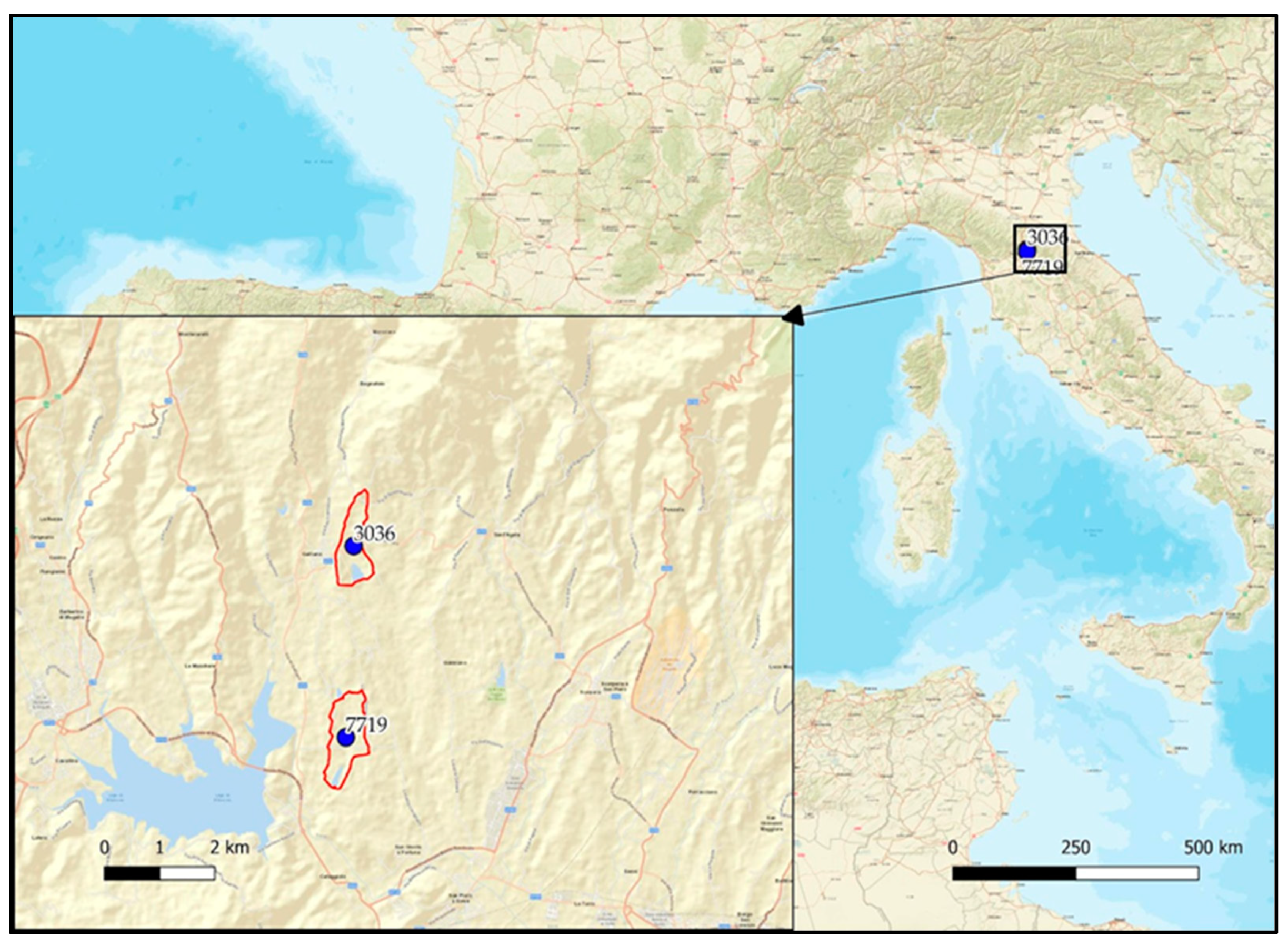
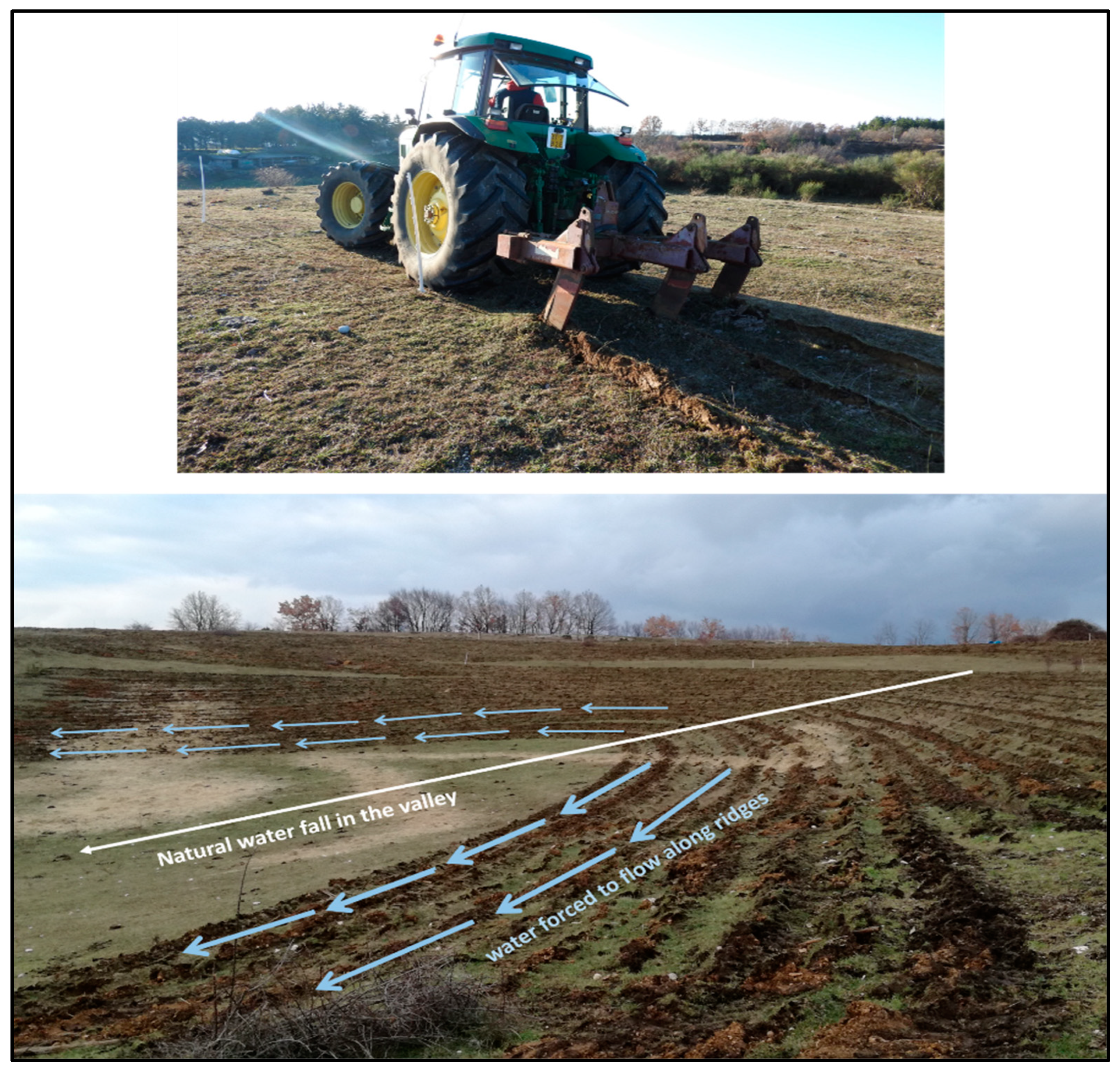


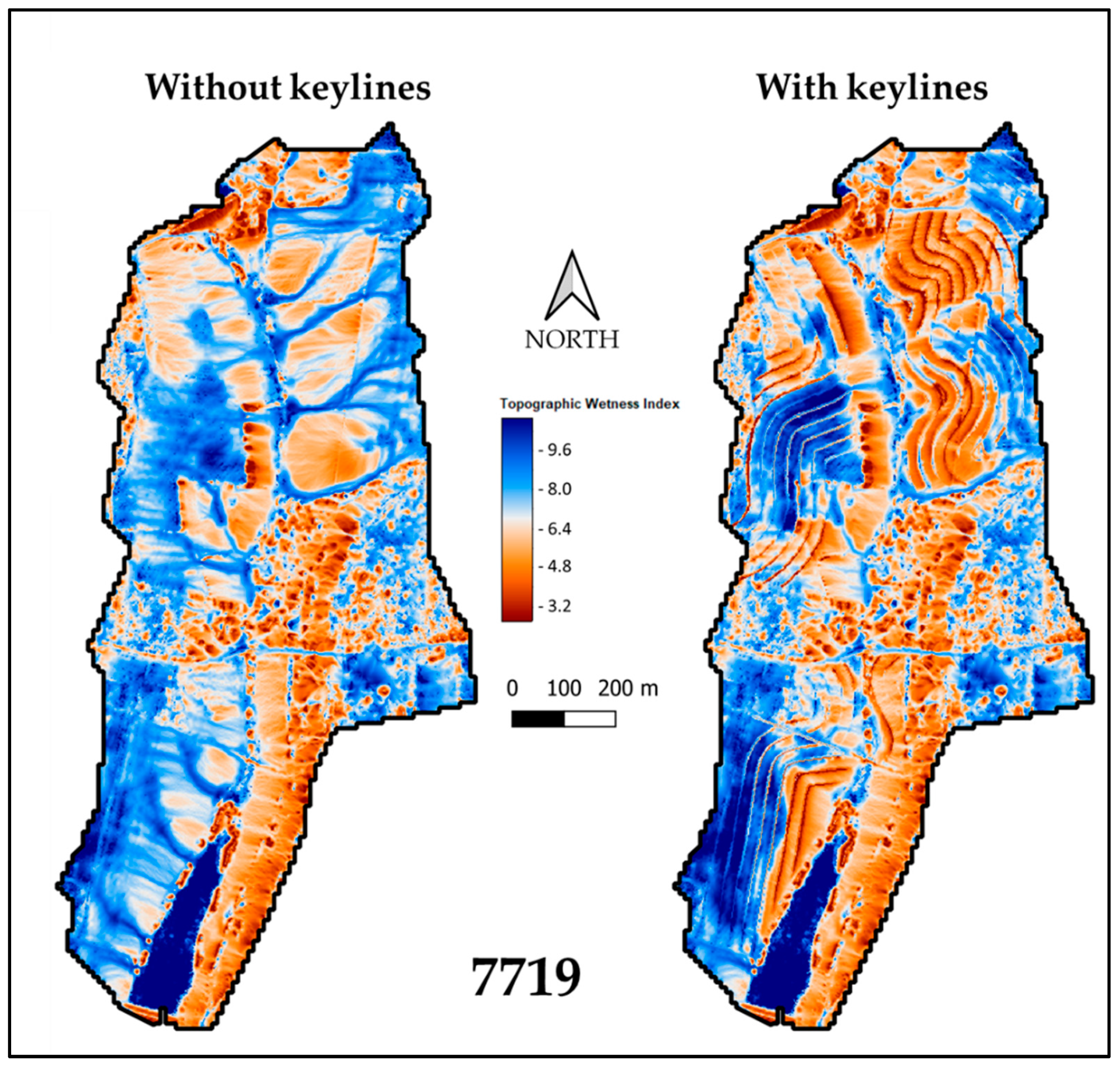
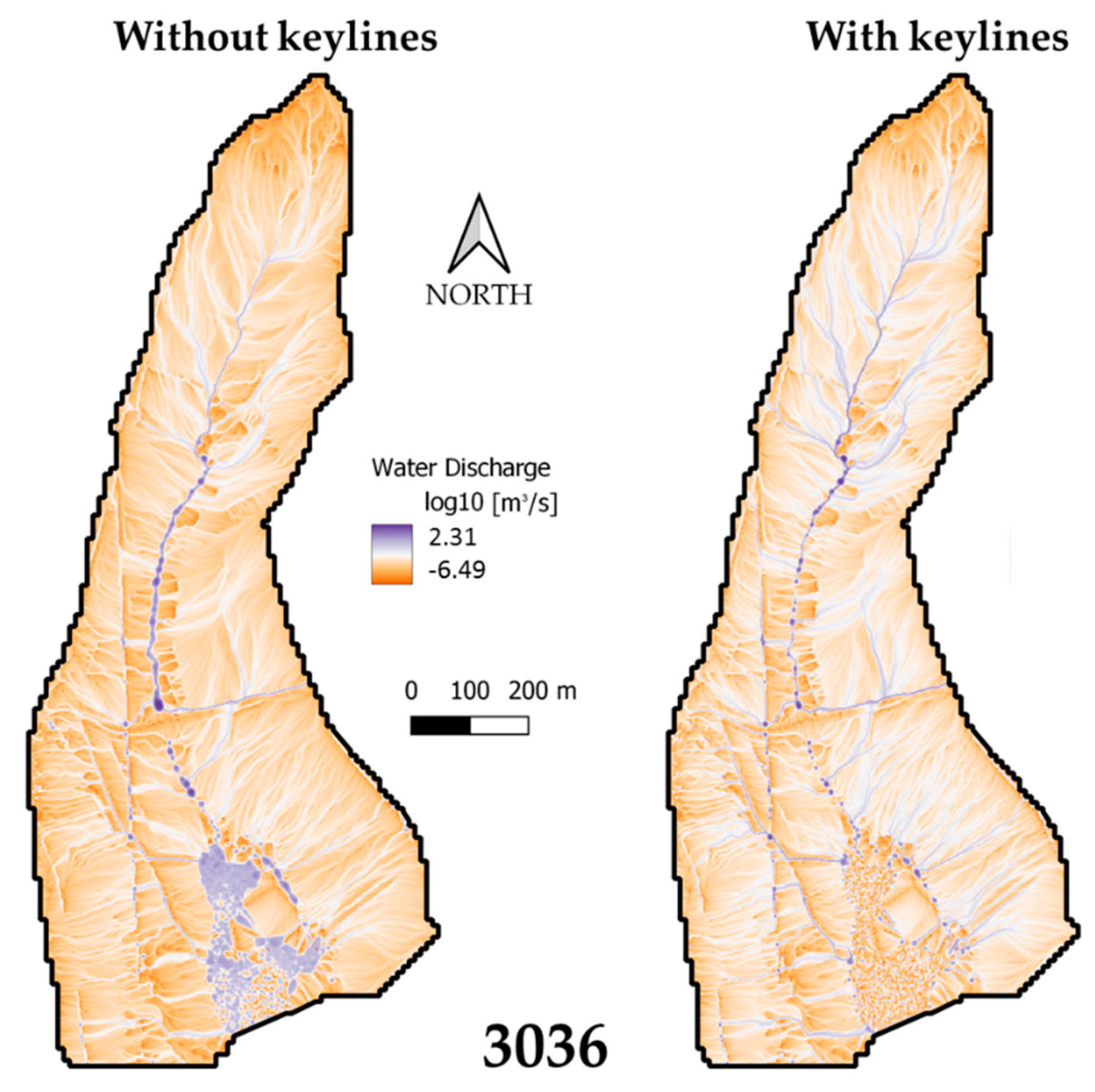
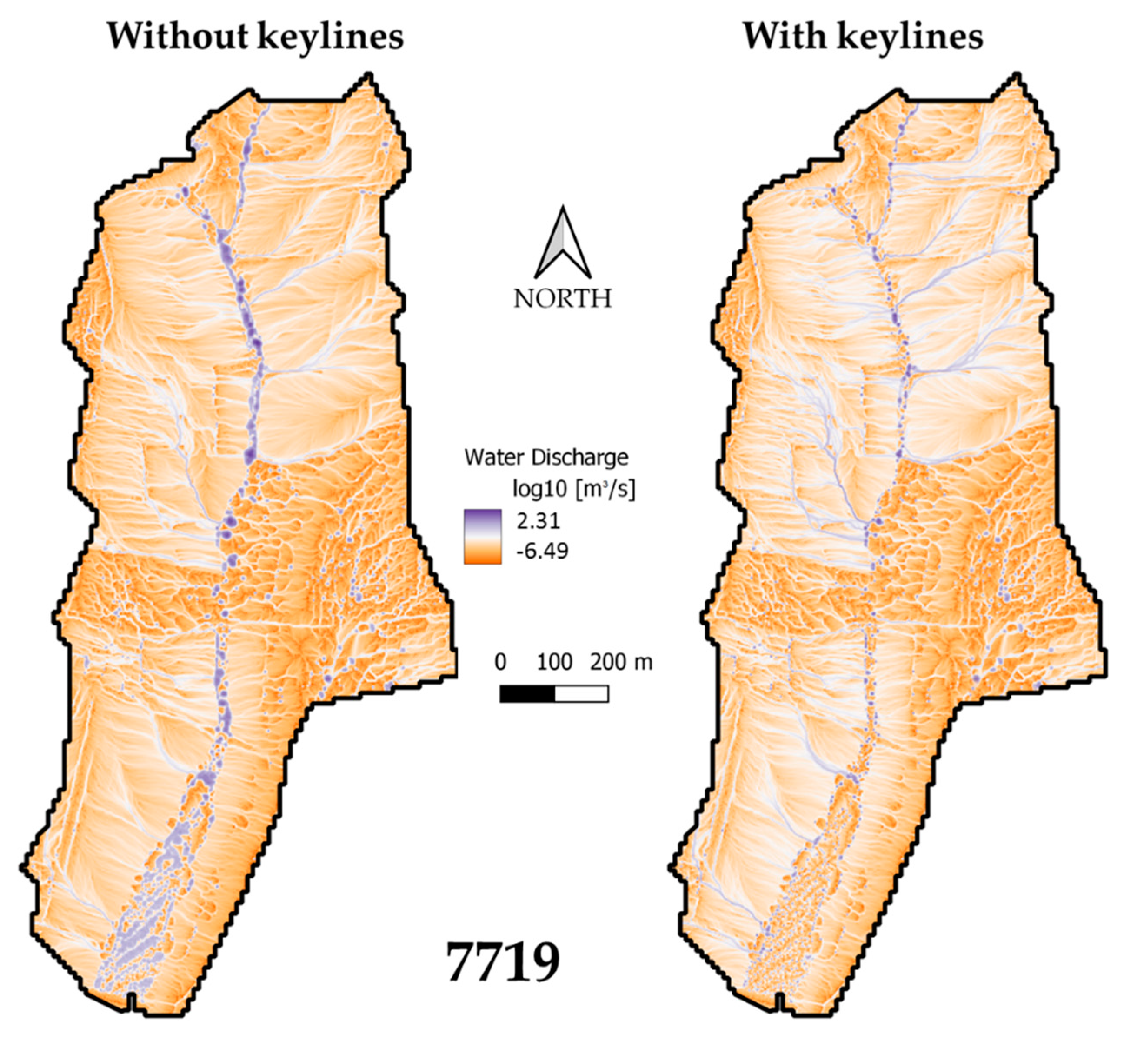
| ID Basin | UM | 3036 | 7719 |
|---|---|---|---|
| Pixel | number | 168,120 | 217,619 |
| Basin Area | m2 | 67.25 | 87.04 |
| Total keylines | m | 15,470.3 | 15,356.6 |
| Keyline density | m/ha | 230.1 | 176.4 |
| Mean Water Discharge without keylines | m3/s | 0.178 | 0.124 |
| Mean Water Discharge with keylines | m3/s | 0.164 | 0.108 |
| Reduction | % | 8.18 | 12.34 |
Disclaimer/Publisher’s Note: The statements, opinions and data contained in all publications are solely those of the individual author(s) and contributor(s) and not of MDPI and/or the editor(s). MDPI and/or the editor(s) disclaim responsibility for any injury to people or property resulting from any ideas, methods, instructions or products referred to in the content. |
© 2022 by the authors. Licensee MDPI, Basel, Switzerland. This article is an open access article distributed under the terms and conditions of the Creative Commons Attribution (CC BY) license (https://creativecommons.org/licenses/by/4.0/).
Share and Cite
Giambastiani, Y.; Biancofiore, G.; Mancini, M.; Di Giorgio, A.; Giusti, R.; Cecchi, S.; Gardin, L.; Errico, A. Modelling the Effect of Keyline Practice on Soil Erosion Control. Land 2023, 12, 100. https://doi.org/10.3390/land12010100
Giambastiani Y, Biancofiore G, Mancini M, Di Giorgio A, Giusti R, Cecchi S, Gardin L, Errico A. Modelling the Effect of Keyline Practice on Soil Erosion Control. Land. 2023; 12(1):100. https://doi.org/10.3390/land12010100
Chicago/Turabian StyleGiambastiani, Yamuna, Gherardo Biancofiore, Matteo Mancini, Antonio Di Giorgio, Riccardo Giusti, Stefano Cecchi, Lorenzo Gardin, and Alessandro Errico. 2023. "Modelling the Effect of Keyline Practice on Soil Erosion Control" Land 12, no. 1: 100. https://doi.org/10.3390/land12010100






